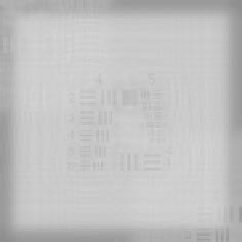Biomedical Engineering Reference
In-Depth Information
(a)
(b)
(c)
4
5
2
3
4
5
6
1
2
6
4
1
FIgurE 9.5
Amplitude of an object wave and of its reconstructions from an off-axis hologram, with different
approaches for numerical field propagation. (a) Initial object, (b) convolution, and (c) single Fourier transform.
The convolution formulation of the propagation, despite the fact of being a little bit more time con-
suming in computing, has several advantages over the FFT version. Indeed, the fields in the hologram
and image plane have the same sampling step. This means that the size of the propagated image is at the
same scale as the one in the hologram plane. This is illustrated in Figure 9.5b, where the size (in pixel) of
the reconstructed image has the same size, independently of the reconstruction distance. Probably for
that reason alone, it is the most widely used implementation.
9.4.1.4 Single 2D Fourier transform numerical Field Propagation
Equation 9.4 can be developed to a single, two-dimensional Fourier transform:
exp
ikd
i d
(
)
i
π
λ
i
π
λ
(
)
ψ
=
exp
ξ
2
+
η
2
F
ψ
exp
(
x
2
+
y
2
)
,
(9.7)
d
λ
d
0
d
where
ξ
/
d
and
η
/
d
are the spatial frequencies. Equation 9.7 can be straightforwardly discretized and
computer implemented, as, for example, in Schnars and Juptner (2002). As it consists of only one Fourier
transform, it is very fast. In this implementation of the Fresnel propagation, however, the sampling step
in the reconstruction plane varies with both λ and
d
. This leads to reconstructions like the one in Figure
9.5c, where the size (in pixels) of the imaging terms varies with the reconstruction distance. The advan-
tage of this implementation is to allow spatial separation of the zero-order and diffraction terms, just as
it is the case in classical off-axis holography.
9.4.2 elimination of Zero-order terms and twin image
In Section 9.2.5, we discussed the elimination of the zero-order and twin image terms in classical holog-
raphy. We have mentioned that appropriate balancing of the object and reference wave intensities could
help reduce the importance of these undesired terms, and we have also described a method to completely
remove them that is based on an off-axis optical configuration, in which an angle between the object and
the reference waves spatially separates the reconstructed terms to avoid overlap.
With digital holography, there exist two schools of thoughts for elimination of the undesired zero-
order and twin image terms. Spatial frequency filtering in an off-axis optical configuration is 1. The
other relies on phase-shifting algorithms.
























